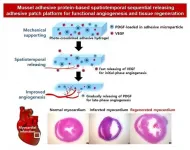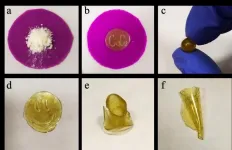Blood vessel formation in damaged tissues with mussel adhesive protein
2021-04-12
(Press-News.org) Blood vessels deliver nutrients and oxygen to each organ in our body. They are difficult to completely restore to their original conditions once damaged by myocardial infarction or severe ischemic diseases. This is because various angiogenic growth factors must be applied sequentially in order to restore the vascular structure. Recently, a research team at POSTECH has bioengineered a novel adhesive patch platform that can efficiently deliver blood vessel-forming growth factors spatiotemporally using mussel adhesive protein (MAP), a bio-adhesive material that is made from mussels harmless to humans.
A POSTECH research team led by Professor Hyung Joon Cha and Dr. Tae Yoon Park of the Department of Chemical Engineering has developed a drug-delivering adhesive patch using two formulations - coacervate-based microparticles and light activation-based crosslinked hydrogels - that can be mass-produced. The team verified their effectiveness in tissue regeneration including neovascularization using a rat model for myocardial infarction and excisional wound model incapable of self-healing.
The research team produced microparticles by instantaneously encapsulating and crosslinking platelet-derived growth factor (PDGF) required for the late-phase angiogenesis during the process of forming coacervate microdroplets formed by the electrostatic interaction of MAP and hyaluronic acid.
In addition, PDGF-loaded microparticles and the vascular endothelial growth factor (VEGF) required for initial-phase angiogenic factor are simultaneously encapsulated in a MAP-based crosslinked hydrogel, spatially separated and mounted the two factors easily and quickly.
This effective novel angiogenesis-inducing platform showed that PDGF was secreted and delivered 1.9 times later in time despite its smaller size than VEGF. In addition, the team confirmed that the platform allows crosslinking to occur instantaneously so that it can easily adhere even to uneven curved surfaces.
"We have developed a new platform that can efficiently deliver angiogenic factors spatiotemporally by using the formulation property of MAP, an original biomaterial," remarked Professor Hyung Joon Cha who has long devoted himself to studying the MAP. "It is of great significance that we have confirmed the functional recovery beyond effective neovascularization by applying it to actual animal model of myocardial infarction and severely damaged skin model."
"It will be successfully applicable to chronic and ischemic diseases in a similar environment." He added eagerly, "This platform can play a key role in the neovascularization treatment market as it uses biocompatible biomaterials that are harmless to the human body."
INFORMATION:
This MAP-based hydrogel and coacervate liquid microdroplets fabrication technology have undergone a technology transfer to Nature Gluetech Co., Ltd. and is currently being commercialized.
The finding of this study was published in Biomaterials, the most authoritative journal in the field of biomaterials. The study was conducted with the support from the health and medical technology development project supported by the Ministry of Health and Welfare and the Korea Institute for Health Industry Promotion, and as part of the Nano-New Materials Core Technology Development Program of the Ministry of Science and ICT and the National Research Foundation of Korea.
[Attachments] See images for this press release:

ELSE PRESS RELEASES FROM THIS DATE:
2021-04-12
Squirrels and other tree-dwelling rodents evolved to have bigger brains than their burrowing cousins, a study suggests.
This greater brain power has given them key abilities needed to thrive in woodland habitats, including better vision and motor skills, and improved head and eye movements, researchers say.
Scientists have shed light on how the brains of rodents - a diverse group that accounts for more than 40 per cent of all mammals - have changed since they evolved around 50 million years ago.
Few studies looking into factors affecting brain size in mammals have taken account ...
2021-04-12
New Orleans, LA - A study led by Hui-Yi Lin, Ph.D., Professor of Biostatistics, and a team of researchers at LSU Health New Orleans Schools of Public Health and Medicine has found that adequate levels of five antioxidants may reduce infection with the strains of the human papillomavirus (HPV) associated with cervical cancer development. Findings are published in the Journal of Infectious Diseases.
Although previous studies have suggested that the onset of HPV-related cancer development may be activated by oxidative stress, the association had not been clearly understood. This study evaluated associations between 15 antioxidants and vaginal HPV infection status -- no, low-risk, and oncogenic/high-risk HPV (HR-HPV) -- in 11,070 women aged 18-59 who participated ...
2021-04-12
In 2018, Pompeu Fabra University launched its Planetary Wellbeing initiative, a long-term institutional strategy spurred by the United Nations Sustainable Development Goals (SDG) and based on the Planetary Health project promoted by the Rockefeller Foundation and The Lancet.
Fifteen academics and public officials, led by the three directors of the initiative, Josep Maria Antó, scientific director of ISGlobal; Josep Lluís Martí, UPF vice-rector for innovation projects, and Jaume Casals, UPF rector, are the authors of an academic article published in the journal ...
2021-04-12
Cancer is one of the top causes of death worldwide. The cancer burden is related not only to genetic predisposition, but also to environmental pollution and socioeconomic factors such as lifestyle. Consequently, the burden of this disease is not uniform across all countries. In fact, the public health of China, a country known for the rapid change in its development status in the last few decades, has undergone a paradigm shift with respect to cancer incidence and mortality.
To better understand the cancer burden of the country, a team of researchers from Chinese Academy of Medical Sciences and Peking Union Medical College reviewed the data of GLOBOCAN 2020, an online database of cancer incidence and mortality compiled by the International Agency for Research ...
2021-04-12
Researchers at the Laboratory of Cluster Catalysis at St Petersburg University have synthesised polymers from biomass. What makes them different is that they can be easily recycled.
Today, our life is simply unthinkable without polymers. Plastics, fibres, films, paint and lacquer coating - they are all polymers. We use them both in our everyday life and in industry. Yet the goods made from polymers, e.g. bottles, bags, or disposable tableware, are used just once or for a short period of time before they are thrown away. Due to the chemical compounds that they may release during recycling, they pose a real threat to our environment.
There ...
2021-04-12
Study: "Students Enrolled in Late-Start-Time Districts Report Higher Academic Achievement and Sleeping More"
Authors: Julio Caesar (Bloomington Public Schools), Rik Lamm (University of Minnesota), Michael C. Rodriguez (University of Minnesota), David J. Heistad (Bloomington Public Schools)
This study will be presented today at the AERA 2021 Annual Meeting.
Session: Organizational Effects Examining Academic Achievement and Student Support
Date/Time: Saturday, April 10, 2:30 p.m. - 4:00 p.m. ET
Main Finding:
Later school start times are linked ...
2021-04-12
Study: "Exploring the Association Between Student-College Match and Student Outcomes Over Time"
Author: Amanda M. Cook (Northwestern University)
This study will be presented today at the AERA 2021 Virtual Annual Meeting.
Session: Nuances and Challenges to Traditional Notions of College Success
Date/Time: Saturday, April 10, 10:40 a.m. - 12:10 p.m. ET
Main Findings:
Over the past 20 years, bachelor's degree completion rates for students who overmatch (i.e., attend colleges that may appear too academically selective for them) have improved substantially. Over the same time period, bachelor's degree completion rates for students who undermatch (i.e., attend colleges that appear too academically unselective ...
2021-04-12
Study: "Characterizing Remote Instruction Provided by Elementary School Teachers during School Closures due to COVID-19"
Authors: Michael Hebert (University of Nebraska-Lincoln), J. Marc Goodrich (University of Nebraska-Lincoln), Jessica M. Namkung (University of Nebraska-Lincoln)
This study will be presented today at the AERA 2021 Virtual Annual Meeting.
Session: Technology Supports and Experiences During the COVID-19 Pandemic
Date/Time: Saturday, April 10, 10:40 a.m. - 11:40 a.m. ET
Main Findings:
While teachers in spring 2020 felt that 60 percent of their students were prepared for the next grade level, in ...
2021-04-12
Study: "Do Students in Gifted Programs Perform Better? Linking Gifted Program Participants to Achievement and Nonachievement Outcomes"
Authors: Christopher Redding (University of Florida), Jason A. Grissom (Vanderbilt University)
This study will be presented today at the AERA 2021 Virtual Annual Meeting.
Session: On the Road to Equity: Studies of the Impact and Influences of Education Policy
Date/Time: Saturday, April 10, 2:30 p.m. - 4:00 p.m. ET
Main Findings:
Participating in elementary school gifted programs is associated with reading and math achievement for the average student, ...
2021-04-12
There are many questions surrounding the elementary particle neutrino, in particular regarding its mass. Physicists are also interested in whether besides the "classic" neutrinos there are variants such as the so-called sterile neutrinos. The KATRIN experiment has now succeeded in strongly narrowing the search for these elusive particles. The publication appeared recently in the journal Physical Review Letters.
Strictly speaking, the neutrino is not a singleparticle but rather comprises several species: the electron neutrino, the muon neutrino, and the tau neutrino. These particles are constantly transforming ...
LAST 30 PRESS RELEASES:
[Press-News.org] Blood vessel formation in damaged tissues with mussel adhesive protein


